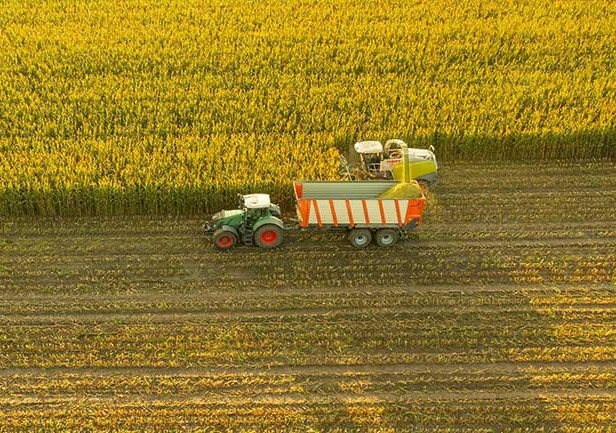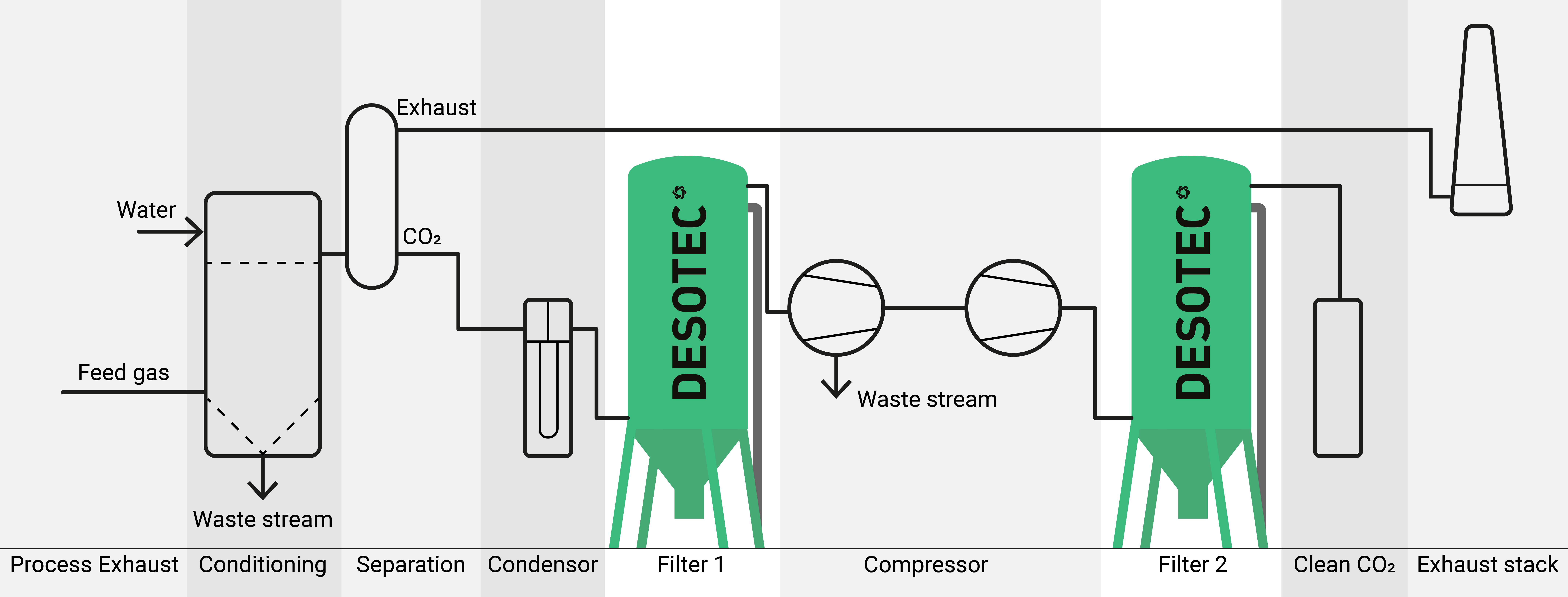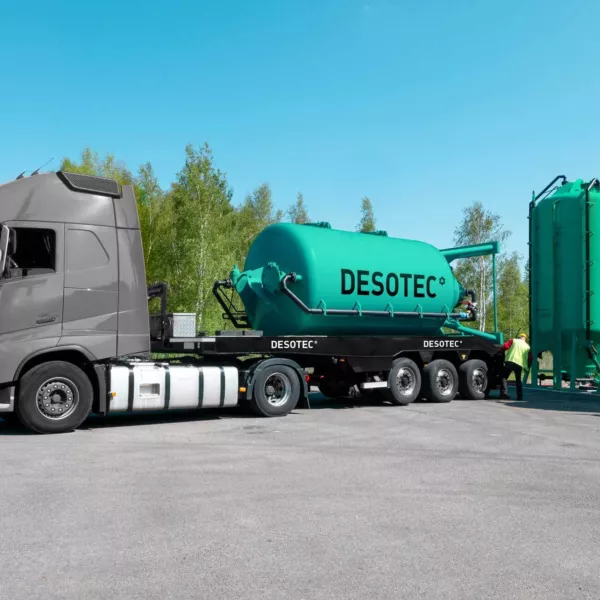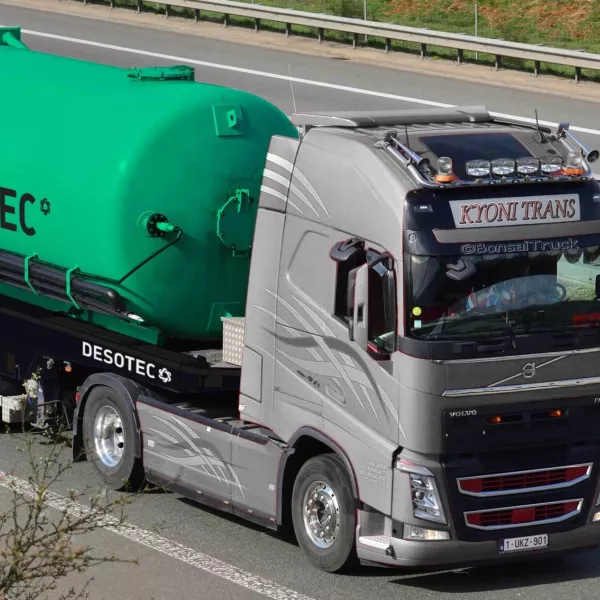Cleaning CO₂ for valorisation
As industry moves towards a net zero future, attention is turning to the valorisation of carbon dioxide (CO₂) off-gas as part of the circular economy. This is coupled with a growing demand for CO₂, e.g. from food and beverage companies, food processing companies, and the emerging sustainable fuel and chemical industry. Valorising CO₂ off-gas needs a clear understanding of its production source, and the impurities to be removed to meet the specifications of different end uses. A suitable cleaning solution can then be designed and offered.
DESOTEC can be part of the solution, by providing sustainable filtration to reduce unwanted components in the CO₂ stream. DESOTEC already contributes to systems for cleaning CO₂ from biogas for use in the food and beverage sector, and have a wide-ranging expertise that may be applied to further industries.
Drivers and markets for CO₂
- Drivers
Until recently, most CO₂ used by European industry originated from ammonia production for fertiliser. However, the recent rise in oil and gas prices has led to a drastic drop in European ammonia production. Therefore, new sources of CO₂ are being sought to improve availability. In North America, CO2 consumption is mainly driven by organic growth of Enhanced Oil Recovery (EOR) and the food and beverage industry.
The EU Green Deal, the EPA Net Zero Initiative and similar legislation around the world encourage the decarbonisation of industry and greening of CO₂ production. Incentives may include tax breaks and subsidies, while carbon trading certificates are also applicable under certain circumstances.
In addition, the growing awareness of climate change is influencing buyers’ decisions in all markets. Biogenic sources of CO₂ such as biogas are particularly sought after as they offer negative emissions, making them more sustainable and cost-effective.


- Markets
Each market has different requirements for CO₂ purity.
For food grade applications, the gas must meet stringent standards. For other markets, specifications are set by end users. In non-food applications, the main reason to purify CO₂ is generally to avoid poisoning downstream catalysts and prevent corrosion of piping and instruments.
Established markets:
- Food and beverage, currently the largest market. CO₂ is used for carbonation and as dry ice for food preservation. For food grade CO2, purity must be high. In the EU, EIGA Document 70/17 stipulates the following limits: total S 0.1 µmol/mol = 0.1 ppm, total volatile hydrocarbons 50 µmol/mol = 50 ppm.
Already, this market is struggling to find CO2. Further roadblocks are the need for certification and traceability, and religious requirements e.g. CO₂ produced from halal sources.
- Food production. Food grade CO₂ is used for: inert atmosphere for packaging e.g. for ham and cheese; stunning methods in slaughterhouses; and fruit preservation in warehouses.
- Industry: welding, water treatment, surface cleaning, electronics etc.
- Chemical production and novel chemicals: e.g. replacing oil with CO2 for PU production for green mattresses; producing sodium bicarbonate; as solvent/ inert atmosphere etc.
- Oil & gas industry: enhanced oil recovery.
- Greenhouses, to speed up vegetable growth.
Emerging markets:
- Sustainable fuels and Power to X (PtX). Methanol and higher molecular weight hydrocarbons are made from CO2 and hydrogen via processes such as direct hydrogenation, Fischer-Tropsch synthesis or methanol to olefins (MTO). It is used for sustainable aviation fuel (SAF) and other synthetic fuels or chemicals. This market is likely to grow substantially in the coming years as countries strive to reach their EU Green Deal targets.
Sources of CO₂
Depending on its origin, off-gas will have different CO2 concentrations, and different components that require cleaning before valorisation.
1- Exhaust gas from thermal processes or combustion of waste, fossil fuels and biogenic fuels. Very large flows are emitted by industries such as steel, cement and construction. This off-gas typically contains 3-20% CO2
as well as moisture, inert gases and also catalyst/microorganism-poisons like carbonyl sulfide (COS), carbon disulfide (CS2) etc. Due to the relatively low concentration, it is energy-intensive to extract this CO₂.
2- Combustible fuel gases produced by biogas plants, refineries, mining, sewage and landfill. These flows typically contain 30-50% CO2
as well as volatile organic compounds (VOCs) like methane, moisture but also catalyst/microorganism poisons like hydrogen sulfide (H2S), siloxanes and other components.
3- CO2-rich gases from the production of ammonia and urea (fertiliser), ethanol (detergents), hydrogen, and ethylene oxide (for detergents and plastics) etc. These off-gases are almost entirely CO2 but also contain moisture, inert gases, VOC, amines etc as impurities.
Components to be cleaned
As shown in above examples, the impurities of an off-gas depend on its origin, while the intended end use determines the level of cleaning required.
These impurities may include:
- Large volumes of H2O, O2, N2, H2, Ar.
- Particulates/ dust, which need to be mechanically separated.
- Traces of components that may be catalyst poisons or toxic for downstream process microorganisms or even human consumption:
- Acidic components such as H2S, SO2, SO3, HCl, HF, COS, CS2, CH3SH, HCN, NO, NO2/NO3, and Cl2.
- Basic components such as NH3 and Amines.
- Combustible components such as CO, CH4, organics.
- Biological organic components such as yeasts and fungi.
- Metallic components such as mercury (Hg), heavy metals (Ni, Cr, etc.), and alkaline and earth alkaline metals (Na, K, Ca, Ba), which occur as aerosols rather than particulate matter.
- Volatile Organic Components such as aromatic hydrocarbons, olefins, aldehydes/ organic acids, dioxins/ furans, oils/ greases etc.
Removing CO2 from gas streams
There are currently four main technologies to remove CO2 from exhaust streams. Today, absorption or adsorption are most frequently used.
1. Absorption/ wet scrubbers
There are several different technologies of which the most prominent is amine wash. Amines capture large amounts of H₂S as well as CO₂. During flash desorption, H₂S is released along with gaseous CO₂, necessitating a further H₂S removal step. Additionally, H₂S gradually degrades the CO₂ loading capacity of amines and reduces their lifetime. Therefore, H₂S should preferably be removed upstream from the amine scrubbing, or at least downstream if the CO₂ is to be valorised, along with other impurities listed above.
Typically, the first step is to dissolve the CO₂ gas into an appropriate liquid, e.g. lean amine, in a column scrubber. The second step is to desorb the CO₂ in a second column. Afterwards, the CO₂ must be dehydrated and cleaned. It is then likely to be compressed and cooled or even liquefied to around 2 MPa and -20°C. It is then ready for transport, storage and ultimately supply to the end-user.
2. Adsorption procedures
Temperature swing or pressure swing on activated carbon (carbon molecular sieves) or zeolites is often used in biogas applications and smaller plants to clean CO2 from permanent gases such as methane, nitrogen, oxygen, H₂O and Ar. However, trace amounts of the impurities mentioned above slip through this stage and may need cleaning.
3. Cryocondensers
This technology generally separates CO₂ from moisture and permanent gases. It cannot achieve very low concentrations of contaminants. The standard turbines and coolers that are used with every CO₂ stream may be boosted to act as an effective cryocondenser. However, on its own, this may not be enough to meet every specification, which may make additional cleaning necessary to reduce other impurities.
4. Membranes
These separate high CO2-concentration off-gases from acid gases, biological matter, some VOCs, and aerosols. They need optimal operating conditions such as temperature, pressure and humidity. Often, higher VOC concentrations can lead to membrane fouling. For certain off-gases this separation technology can be a viable option, even if several membranes have to be put in series for high CO₂ concentrations.
Cleaning CO₂ with activated carbon
Once the CO2 has been separated, the CO2 stream may contain residual water plus traces of impurities as listed above. Therefore, in many cases it will have to be cleaned.
Activated carbon filtration is a proven technology, commonly used to clean or polish CO₂. It offers the following key benefits:
- Removal of VOCs, acid and basic components, mercury, halogen components, organics, sulphur and odours.
- Highly useful as a polishing step after other technology, reducing the last traces of components to below detectable levels.
- Potential to clean both air/ gas and water/ liquid flows.
- Straightforward to install and use.
- Handling of varying flow rates, making it suitable for batch or intermittent processes.
- Circular process, producing waste that may be reactivated for further use, boosting sustainability.
Activated carbon filtration has the following limitations:
- It can be uneconomical for very large flows, e.g. from heavy industry.
- It cannot separate out permanent gases, methane, ethane, or particulates.
A typical cleaning process using activated carbon

DESOTEC would be either between the cooler and compressor (Filter 1), or after the compressor (Filter 2) or before the separation (Conditioning) technology.
DESOTEC’s mobile sustainable filtration solutions
DESOTEC supplies mobile sustainable solutions using activated carbon to companies in a range of industrial sectors, in Europe and North America.
Our modular filter fleet allows for flow rates from a few hundred cubic meters per hour (m³/ h) up to 55 000 m³/ h in gas phase, and 2 m³/ h to 50 m³/h in liquid phase. By placing filters in parallel, higher flows are also treatable.
We offer a range of carbon grades to treat and capture different components. For acidic/ basic impurities such as ammonia, amines, HCl, HCN, H₂S, etc and metals like mercury, impregnated carbon is used.
Sustainable filtration waste handling is key to our circular service. All filtration waste is transported in closed filters away from customers’ sites and taken to our state-of-the-art facilities. Components adsorbed onto the carbon are desorbed and broken down in DESOTEC’s furnaces, or valorised. In most cases, the active carbon is reactivated for reuse, driving down customers’ costs, improving sustainability and lowering our and your CO2 footprint.
Case study: cleaning CO₂ from a biogas plant for the food and beverage sector
This Danish plant produces biogas from food waste and agricultural residues.
Once the methane is extracted for energy generation, there is a CO₂ off-gas stream. In most biogas plants, the CO₂ would be released into the atmosphere after cleaning – but here, it is being valorised.
DESOTEC supplies two AC3000PE filters, placed in parallel, as part of a treatment system that includes other technology such as a compressor. The off-gas flow is 2250 m³/h, and contains 50 ppm of H₂S and 2 000 ppm of VOCs, rest is CO₂.
The client’s measurements show that after treatment, almost no impurities remain in the CO₂ stream, making the product fit for use in the beverage industry.
The cleaned gas is stored in two tanks, ready for transportation by truck to customers in the beverage sector.
How can DESOTEC help you?
To discuss how DESOTEC’s mobile sustainable filtration solutions could clean CO₂ in your company, contact our team of engineers today.
Contact our expertsHow can DESOTEC help you?
To discuss how DESOTEC’s mobile sustainable filtration solutions could clean CO₂ in your company, contact our team of engineers today.
Contact our experts-
Our filtration solutions
We offer a wide range of filter models and carbon grades to suit your industrial water or air purification requirements. -
Our unique service
Our closed-loop, full-service model is as unique as your business needs. We’ll define the right filtration setup and safely recycle filtration waste, making it easy to go green. -
Your sustainability journey
We care about protecting our air, water and soil for future generations, just like you. Our filtration solutions help you meet environmental standards, reducing your carbon footprint.


